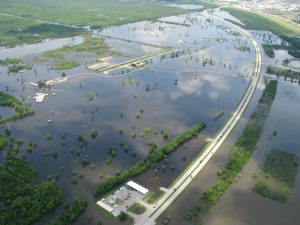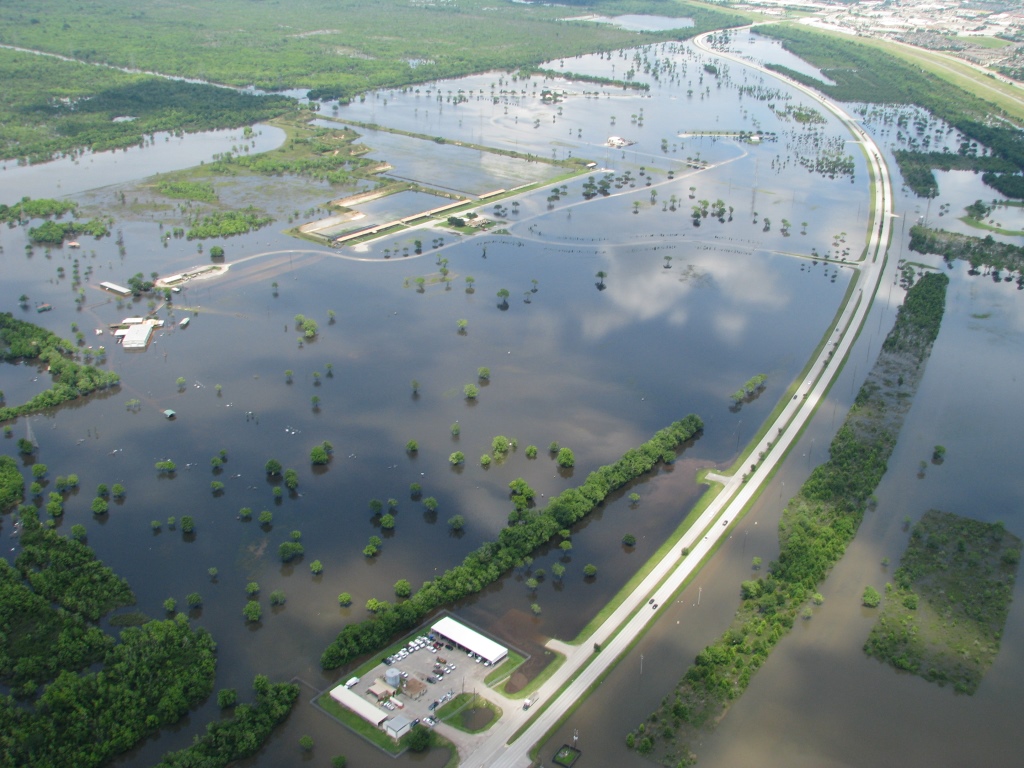
Coastal Houston is prone to frequent, year-round flooding, a problem made worse by the city’s quickly growing population and its dwindling natural flood control landscapes.
In this photo, roads near dams were forced to close in Spring 2015 due to flooding concerns. One year later, a single storm brought almost 457 mm (18 in.) of rainfall to the Houston metro area, spurring the worst flood event to affect the city since Tropical Storm Allison hit the area in 2001. (U.S. Army Corps of Engineers)
The City of Houston, Texas, and the Harris County Flood Control District (HCFD; Houston) are teeing up to build 10 stormwater detention basins on the site of the now-defunct Inwood Forest Golf Course in northwest Houston. Once completed, officials expect the network of basins to detain more than 1.3 billion L (350 million gal) of stormwater.
The project responds to a need for effective flood control measures in the White Oak Bayou watershed, highlighted by a severe storm in mid-April of last year. The storm dropped almost 457 mm (18 in.) of rain across the Houston metro area in a single day. The flooding caused the death of eight people; necessitated the rescue of more than 1800 residents from high water; and damaged more than 1000 homes, apartments, and businesses, the Houston Chronicle reports.
A hole-in-one proposition
In residential areas, stormwater detention basins usually are designed and installed in the early stages of community planning. At Inwood Forest Golf Course, engineers with HCFD will retrofit the tanks into the already established 92-ha (227-ac) property. The City of Houston purchased the golf course for $9.3 million in 2011 as part of an arbitration process involving development rights. In the years since, the city spent $2.5 million to develop and construct two stormwater basins on the course already capable of detaining about 69,000-m2 (56 ac-ft).
“It’s fairly large in the grand scheme of things,” Alan Black, HCFD director of engineering, told the Houston Chronicle. “To be able to find an opportunity to create [1.2 million m2 (1000 ac-ft)] of storage in an area that’s completely built out is amazing.”
After receiving the green-light from the Houston City Council during a Feb. 14 meeting, Harris County now will allocate about $20 million to design and develop the eight remaining basins. Construction on the project, which aims to accommodate up to 1.3 million m2 (1052 ac-ft) of stormwater, is expected to begin in 2018. In the meantime, HCFD will continue to compile a detailed inventory of trees in the area to determine where to build the basins so as to minimize disturbance to the site’s ecosystem.
HCFD officials told the Chronicle that successful completion of the stormwater basins effectively will move an estimated 400 homes and businesses out of the White Oak Bayou’s 100-year floodplain.
Water hazard
Faced with explosive population growth, deteriorating permeable surfaces, and chronic susceptibility to flooding, the Houston metro area is among the most at-risk cities in America for urban flooding.
Population growth numbers in Houston between 2010 and 2015 were the highest in the country with a change of more than 736,000 city residents, according to the U.S. Census Bureau. The heavy influx of city residents in recent years has driven developers to build accommodations wherever possible, often at the expense of surrounding wetlands and farms that would absorb or redirect stormwater runoff. In 2015, the Houston Advanced Research Center released a study claiming that “more than [15,400 ha (38,000 ac)] of wetlands vanished in greater Houston over the past two decades.”
According to the Houston-based Weather Research Center, there have been at least 26 major flood events in the Houston metro area over the last four decades, happening in every season. Already subject to frequent precipitation, much of the downtown Houston area sits just 13 m (43 ft) above sea level, and as climatologists predict rainfall to intensify and sea levels to rise dramatically by the end of the century, these flood events show no signs of becoming less common.






